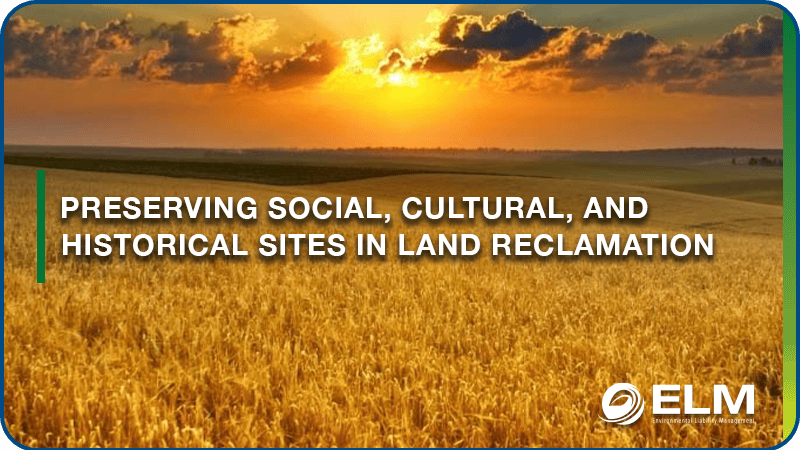Preserving Social, Cultural, and Historical Sites in Land Reclamation

This article highlights the significance of preserving social, cultural, and historical sites within land reclamation projects. These sites serve as a crucial link to cultural identity, promoting community pride and a sense of belonging. Preserving them also contributes to sustainable tourism, offering authentic experiences and economic opportunities for local communities. By integrating these sites, land reclamation projects can strengthen community bonds, provide educational opportunities, and conserve architectural heritage. These efforts strike a balance between development and heritage preservation, fostering social cohesion and creating sustainable spaces. It is essential to recognize and respect the value of these sites, as they play a vital role in preserving our collective heritage and ensuring the sustainable development of our communities for future generations.
Land reclamation projects often involve transforming underutilized or degraded land into productive and sustainable spaces. While these projects offer numerous benefits, it is crucial to consider the preservation of social, cultural, and historical sites within the reclamation process. These sites hold immense value in terms of heritage, identity, and community cohesion. In this article, we will explore the importance of preserving such sites in land reclamation and provide supporting statements to underscore the significance of this endeavor.
Protecting Cultural Identity: Social and cultural sites, including traditional villages, indigenous settlements, and historical landmarks, play a vital role in preserving a community's cultural identity. These sites serve as a tangible link to a community's past, enabling future generations to connect with their roots and heritage. By integrating these sites into land reclamation projects, we ensure the continuity of cultural traditions, stories, and practices, fostering a sense of pride and belonging within the community.
Promoting Sustainable Tourism: Preserving social, cultural, and historical sites in land reclamation not only benefits local communities but also contributes to sustainable tourism. These sites often attract tourists seeking authentic cultural experiences and historical insights. By incorporating these sites into reclamation plans, we can create a harmonious balance between development and heritage preservation, generating economic opportunities for local communities through responsible and sustainable tourism practices.
Strengthening Community Bonds: Social and cultural sites act as gathering places where communities come together, celebrate traditions, and engage in shared activities. These sites foster a sense of community pride, solidarity, and belonging. In land reclamation projects, preserving these sites ensures the continuity of social interactions and traditions, reinforcing community bonds and promoting social cohesion.
Educational Opportunities: Historical sites offer invaluable educational opportunities, enabling individuals to learn about past events, cultures, and societal development. By preserving and integrating these sites into land reclamation projects, we create open-air classrooms where people can engage in experiential learning. Educational programs, guided tours, and interpretive signage can further enhance the educational value of these sites, offering insights into history, architecture, art, and local traditions.
Conservation of Architectural Heritage: Historical buildings and structures are a testament to the architectural expertise and craftsmanship of past generations. They embody a unique blend of art, design, and historical significance. Preserving these structures within land reclamation projects showcases the importance of architectural heritage and provides opportunities for their adaptive reuse. This approach not only safeguards historical structures from deterioration or demolition but also promotes sustainable development by integrating them into modern designs.
In conclusion, the preservation of social, cultural, and historical sites within land reclamation projects is of paramount importance. These sites hold intrinsic value in terms of cultural identity, sustainable tourism, community bonds, education, and architectural heritage. By incorporating these sites into reclamation plans, we strike a balance between development and heritage preservation, fostering community pride, strengthening social cohesion, and creating sustainable and inclusive spaces. It is our responsibility to ensure that land reclamation projects respect and celebrate the rich tapestry of social, cultural, and historical sites, thus contributing to the sustainable development of our communities and preserving our collective heritage for generations to come.
Related Services
Remediation and Reclamation
Pre-Site Assessment & Reporting
Preserving social, cultural, and historical sites in land reclamation projects is crucial for several reasons. These sites hold immense value in terms of cultural identity, allowing communities to maintain a connection with their roots and heritage. Integrating these sites promotes sustainable tourism, generating economic opportunities for local communities. Additionally, preserving these sites strengthens community bonds and fosters social cohesion. It also provides educational opportunities, allowing individuals to learn about the past, architecture, and local traditions. Lastly, conserving architectural heritage showcases the craftsmanship of previous generations and promotes sustainable development through adaptive reuse.
The integration of social, cultural, and historical sites in land reclamation projects requires careful planning and collaboration. It involves conducting thorough assessments to identify significant sites and their historical, cultural, and social value. Engaging with local communities and stakeholders is essential to understand their perspectives and ensure their active participation in the decision-making process. Incorporating these sites into the project design, such as through adaptive reuse of historical structures or the creation of cultural spaces, allows for their preservation and integration. Implementation of educational programs, guided tours, and interpretive signage further enhances the value of these sites. Continuous monitoring and maintenance of these sites are necessary to ensure their long-term preservation and sustainable use.
COMPETITIVE, CAPABLE, AND EXPERIENCED
ELM is the ready partner you want on your team when managing environmental liabilities.
Contact our team by calling 1-587-392-4000 or completing our form below.


